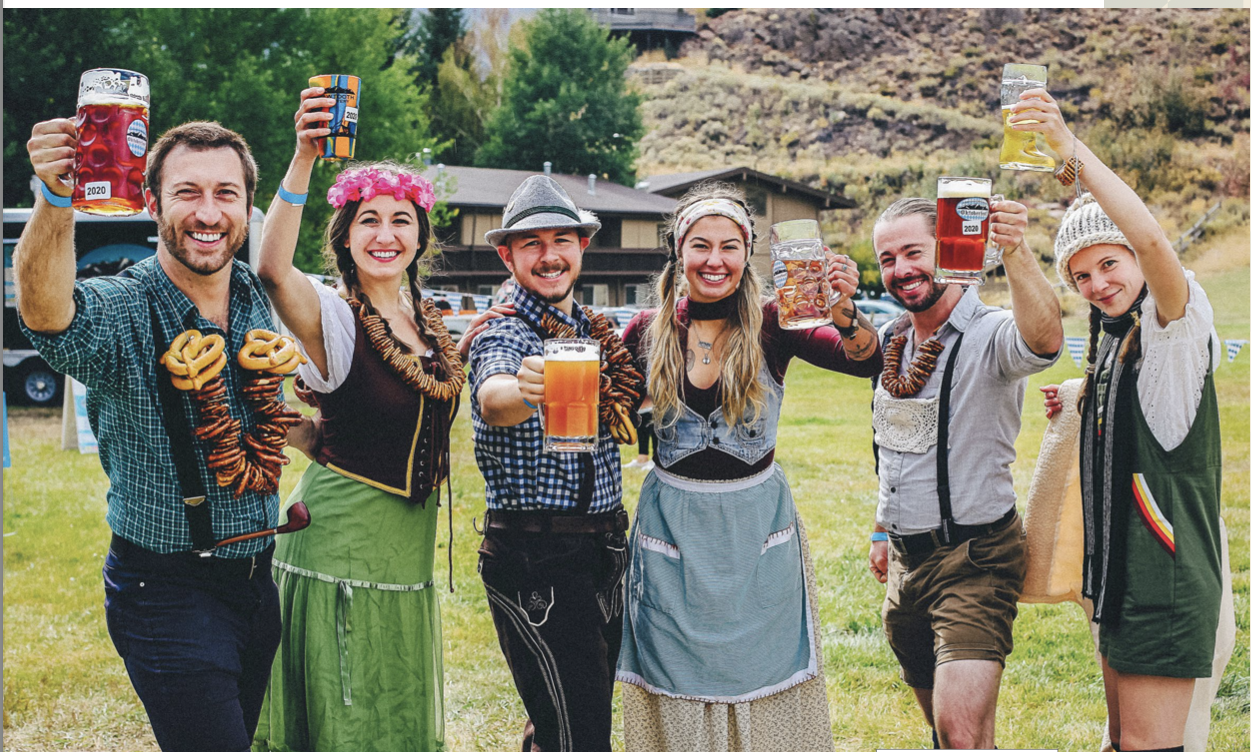When the summer days begin to give way to longer, chillier fall nights, one is immediately reminded of how fleeting our warm summer days truly are. And as fall begins to manifest itself in earnest, the foliage puts on its show, and the peaks of the valley begin collecting their first dustings of snow. But before the harshness of the Rockies truly sets in, Oktoberfest comes around to give us a great excuse to convive under the sun once more, before we hole up for the long haul.
Like so many culturally inspired events on the average American’s calendar (think St. Paddy’s & Cinco de Mayo), the origin and significance of the traditions have been largely washed out and replaced with a simplistic day of costumed drinking. To help you avoid complete ignorance this Oktoberfest—and also to add a few arrows to your trivia night quiver—here’s some of the good bits to know.
Common Misconceptions:
– Oktoberfest only happens in October – Only three days of Oktoberfest fall in October, while the first 13-15 days are at the end of September.
– Märzen or Festbier are the only styles of beer poured at the festival – According to the German purity law (Reinheitsgebot), as long as the beer has been brewed in the city limits by one of Munich’s six breweries (Paulaner, Spaten, Löwenbräu, Augustiner-Bräu, Hofbräu-München, and Hacker-Pschorr), then it is permitted to be poured, meaning there are dozens of styles of beer that qualify as Oktoberfest beer.
– Oktoberfest is only about the beer – Beyond the famed beer halls, Oktoberfest truly has something for everyone. It is by definition a Volksfest or folk festival, and it is all about bringing people together. The event is even family friendly, and in 2005 instituted rules governing noise in effort to ensure families felt welcome.
A Brief History of Oktoberfest
1810 – First Oktoberfest
The tradition of Oktoberfest was born out of a royal wedding celebration honoring the Crown Prince of Bavaria, Regent Ludwig I (soon to be King Ludwig I) and Princess Therese of Saxony-Hildburghausen. The occasion was marked with a dramatic horse race and several days of raucous revelry.
1811 – Second Oktoberfest
One rowdy wedding celebration is all well and good, but we have many 19th century Bavarians’ insatiable appetite for merriment to thank for making Oktoberfest an annual ritual. Every journey may start with a single step, but it is the commitment to taking the next step that is equally important, and in 1811, the people of Bavaria agreed that they were ready to party all over again.
1819 – Munich Takes the Reins
After several years of privately funded good times, the city leadership in Munich decided to take up the mantle. Whether it was simply an act of civic pride or the prospect of partaking in the event’s perennially full coffers, Oktoberfest officially became a public institution.
1881 – Welcome the Meats
Somehow Oktoberfest managed to go 71 years without a single meat vendor. In 1881, both bratwurst and traditional roasted chicken booths made their first appearance as the festival began to take on the modern form known today.
1950 – O’zapft is!
One of Oktoberfest’s most revered traditions was christened in 1950 when the mayor of Munich kicked off the festival with a ceremonial tapping of the first barrel of beer. To this day, Oktobefest cannot commence until this procedural formality is performed.
1994 – Schedule Change
When the Berlin wall finally came down in 1994, festival organizers decided to push the event up, so that every year it would culminate on October 3rd, known as German Unity Day.
An Imperfect Streak
As with many annual traditions, sometimes life gets in the way, and Oktoberfest hasn’t had a perfect run over the last 212 years, with these notable misses:
• 1813 – Napoleonic War
• 1854 – Cholera Epidemic
• 1856 – Austro-Prussian War
• 1873 – More Cholera
• 1914-1918 – WWI
• 1939-1945 – WWII
• 1923-1924 – Hyperinflation (at least our inflation isn’t ‘hyper’?)
• 2020-2021 – Pandemic
The Beer
The first style of beer to become synonymous with Oktoberfest was the Märzen, or March Beer. Brewed in March, this beer wasn’t originally designated to age over the summer months to be ready just in time for Oktoberfest, but rather because of a safety ordinance issued by Bavarian lawmakers in 1553, long before the advent of Oktoberfest. This decree stated that no beer should be brewed between April 23rd and September 29th to avoid fires and explosions from boiling unfermented wort in the heat of the summer. The coincidental timing of the Märzen in tandem with its perfect balance and all-day drinkability cemented its place as the preferred pint of Oktoberfest goers. Festbier, an offshoot of the Märzen style features a slightly more muted malt character, higher alcohol content, and a bit more hop bitterness.
The Garb
Lederhosen – Translation: Leather breeches. Originally used predominantly as workwear due to the leather’s burly nature, these traditional pants are nearly always accompanied by embroidered suspenders.
Loferls – The calf warmer and Bavarian cousin to the ubiquitous 1980’s legwarmers, Loferls provide classically Bavarian style and function, keeping the chill of the fall breeze at bay.
Dirndl – A form fitting bodice with low neckline worn over a blouse, the dirndl-clad woman deftly handling an obscene number of brimming beer steins has become the enduring icon of Oktoberfest.
Tyrolean Hat – No traditional costume would be complete without the appropriate headwear. For the gents, the Tyrolean hat will do. For the well-to-do, your hat should be appropriately adorned by your Gamsbart, which is a showy tuft of hair from the local chamois goat, sized proportionally to match the individual’s wealth and bravado of course.
How to Celebrate Locally
Sawtooth Brewery’s Oktoberfest – September 16th & 17th at Sun Valley Festival Meadows
Going strong for its 10th year, Sawtooth’s Oktoberfest celebration is returning the Sun Valley Festival Meadows this September. After introducing Hammerschlagen to the Wood River Valley at their first Oktoberfest in 2012, the list of outdoor games of leisure still feature prominently in this year’s event and have expanded to include Spikeball, KanJam, and the classics Flip Cup and Beer Pong (capitalized out of reverence). For those wishing to live out the glory portrayed on screen in the cult classic film Beerfest, team Beer Olympics is a must.
Beyond the beer and games, there will be plenty of live music throughout both days, with David Henry Band headlining. Remember that your Sawtooth beer stein is your ticket, so if you’ve got an old mug kicking around from one of the other nine years, bring it with you, and you’ll need only pay for your fills. More info at ketchumoktoberfest.com.
Warfield Distillery & Brewery’s Oktoberfest Celebration – October 1st at Warfield on SV & Main
Warfield’s 3rd annual Oktoberfest puts traditional German food and classic festbier front and center. Grab some friends and family and pull up a seat at their pub on the corner of Sun Valley Road and Main Street in Ketchum. Order from a menu of the classics, including weiner schnitzel, sausage, and Weiner roastbrauten with sherry Jäger sauce. Raise a proper stein or two of their traditional Kriegsfeld (Warfield in German) festbier as you take in the view from one of the best decks in town. For special reduced pricing, purchase your tickets ahead of time. More info at drinkwarfield.com.


